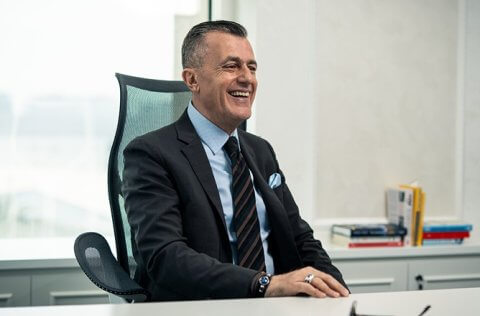CNME Editor Mark Forker sat down with Ossama El Samadoni, General Manager, GBM Dubai, for the front cover of the July-August edition of the magazine, to learn more about the company’s unique approach to rethinking what is required to deliver seamless customer experiences in the new digital era, the challenges and opportunities presented by the advent of Gen AI in the CX space – and how their Customer Service Framework is enhancing operational efficiency and significantly reducing costs for the public sector organisations that implement it. 
Ossama El Samadoni is one of the most respected and revered technology thought leaders in the Middle East.
He started his professional journey as an engineer with IBM in the early 90s, and has enjoyed a remarkable career to date in the 30+ years that have since passed.
El Samadoni has worked for some of the biggest technology companies in the world such as Dell Technologies, Oracle, HP, and NetApp.
He spent the best part of a decade at Dell Technologies, where he held a number of senior executive positions, and it was there where he came to real prominence as a technology leader.
He left Dell in 2021, and joined G42 for 12 months, before he took over as the General Manager of GBM Dubai, in August 2022.
CNME managed to secure an exclusive interview with the charismatic Egyptian, in an effort to learn more about how GBM has continued to stay relevant and evolve, and the direction the company is heading under his tutelage and guidance.
He kickstarted the conversation by highlighting the evolution that has occurred across the CX space over the decades.
“GBM has been in the business for almost 35 years, and during that time we have seen so much evolution and change across the industry. We have also seen the development of what we now call CX (customer experience). In the old days, the name of the game was customer support, and that based on a face-to-face engagement between a customer support agent sitting in an office and a customer coming to visit them. From a public sector perspective, it was a very heavy documentation and workflow driven type of engagement between the customer and the public sector organisation. It then transitioned into the contact centre space, and then moved into the backword integration of applications to support workflow and other elements,” said El Samadoni.
El Samadoni stressed that times have changed, and referenced an article he recently published on LinkedIn, which examined the move from systems of records to systems of engagement.
“In the current climate, customers are mandating how organisations should reach them, it’s not the other way about anymore. Businesses need to go to the engagement space of the customer and serve them on whatever social media applications those customers want to interact with them on. You have to serve the customer on their terms, not yours,” said El Samadoni.

El Samadoni also pointed out that the creation of Customer Happiness Centre really held public sector organisations to account in terms of ensuring they delivered good customer experiences.
“The UAE created the concept of the Customer Happiness Centres, and they are all about ensuring the customer is happy, and that became a key objective for them, rather than just a throwaway catchphrase with no real meaning behind it. Digital transformation on the CX part of the public sector in particular became a continuum rather than a separate function of the contact, connect, or delivery channel functions. When the banks wanted to do compliance they conducted a ‘know your customer’ survey, and we know that was a very painful process, but in the public sector in order to serve their customers well they needed to have a comprehensive 360 degree view of their customers,” said El Samadoni.
El Samadoni revealed that GBM looked at what a CX solution should encompass in terms of functionality in order to build a real solid foundation to drive CX.
“One of the most critical components underpinning all of this is the need to build a data foundation in order to have that 360-degree view on the customers to harness the engagements, and look at whatever non-public sector information about the customers is available that can help tune up the services that are being offered by the organisations. The connection between backend and frontend integration into the business process in the old days was done by writing code, a very hard linked code between what is happening on the frontend, and what needs to happen on the backend. With the evolution of both it actually created an extra dimension of complexity, which resulted in the connection between the frontend and the backend becoming a loose connection, rather than a hard one. Expanding the customer transactions and feedback beyond organisation boundaries is critical, businesses need to go to the space of the customer and determine whether or not they are delivering the services that the customer actually wants, and if they are doing a good job or not,” said El Samadoni.
According to the General Manager of GBM Dubai, multichannel engagement has become a real necessity instead of a nice to have in the current climate.
“Understanding the characteristics and functionality of each organisation makes every different project in CX a unique one, and again that can add to the complexity in terms of where each organisation is in terms of the maturity curve, and what their objective are. In the end, it’s all about determining the art of the possible and establishing what can we do to enhance the customer experience across the board. In order to achieve this successfully, you need to invest time in creating a robust framework that will guide you in terms of integrating the myriad of tools, applications and technologies that you need to make sure everything works seamlessly and in tandem with each other,” said El Samadoni.
El Samadoni then moved the dial of conversation to highlight the five key areas that GBM is focusing on.
“In terms of our approach at GBM, we are focused on five key areas, and one of those areas is modernising infrastructure for proper digital excellence and experience. We can achieve this through multi-cloud hybrid engagement for the integration on open APIs and streaming integration, and to determine what the digital footprint of the customer really is. Secondly, it is critical to make everything data-driven. Essentially, what I mean when I say data-driven is enabling organisations to collect data and have access to it regardless of which engagement space they are in, and that multichannel engagement allows them to do the required analysis to identify what is the next best action that needs to be taken. In addition to this, you also need to look at another dimension which is the integration and automation of the business because you have a backend function that you need to integrate with a frontend function, and it’s not easy to do, and as I said earlier it is all loose. As a result, building trust and security can present challenges because you’re opening up beyond your organisation, and you’re dealing with a customer in a different engagement space,” said El Samadoni.
Interestingly, the General Manager of GBM Dubai, also highlighted that during a CX transformation the entire culture of the organisation is changed as a result.
“CX is one of the areas that actually impacts the culture of transformation on the organisation and has a higher impact than a normal digital transformation journey. With digital transformation you can throw it back at the IT team, but in customer experience everybody is a constituent and everybody is a stakeholder during a typical CX implementation. If you don’t create a collaboration platform in terms of communication, project identification, and project objectives then the project will encounter huge challenges and obstacles,” said El Samadoni.
When pressed on whether there was resistance from some public sector organisations to transform their CX offering, El Samadoni said there wasn’t resistance, but stressed that with CX becoming an important KPI, that inevitably created pressure, and pressure can sometimes lead to mistakes.
“The transformation of the CX space was a seismic change because it changed the mindset and forced people to think about what actually does the customer want. The pressure that we see on top government management, and public sector officials in the UAE comes from the evaluation of how well each organisation is serving their constituents and customers, and so you can only imagine that the pressure is high. However, when the pressure is heightened people can take shortcuts and look for quick results, and don’t do the due diligence on what building blocks they need to implement in order for these results to happen. At GBM, this is the role we are playing with the customers, and we stress to them that it is a journey, it’s not one single project implementation. We adopt a consultative approach with the customer, and we agree on the typical phases of the project, and what is the expected return of each one of the phases, and by doing that, we can ensure that it is an ever-evolving platform, and again this is why it is so important to have a framework of reference,” said El Samadoni.
El Samadoni briefly touched in the architectural framework GBM has established.
“Inside GBM, we have constructed an architectural reference for what CX is all about, it has multiple components, and some of them are mandatory like the foundation, whilst some of them are functional specific. Essentially, depending on what the customer will do the architecture will either grow, or the architecture will contract, or contract with a clear roadmap of growth based on the maturity of the backend, and the maturity execution of the stakeholder,” said El Samadoni.
GBM has developed a Customer Success Services Framework (CSF) that is underpinned by six core service practices.
El Samadoni went into greater detail on what each practice stood for, and said the thinking behind the new framework was to move away from a solution-specific framework to a direct engagement one. 
“We looked at building a framework of reference for how we engage with our customers. It is an engagement framework rather than a solution-specific framework. We deliberately made it as general as possible to make sure we are covering all the critical success factors when we are dealing with the implementation of a digital transformation project with our customers. This approach ensures that the technology deployments remain within the objectives of what the customer wants. We have observed that when you have a lot of constituents and stakeholders with a customer there can be a lot of pull, because everybody is trying to pull the project towards their own domain, or specific department within their organisation. We know that some technical people within some organisations simply love to implement new technologies all the time, but what you need to do is effectively deliver business outcomes to the customer,” said El Samadoni.
El Samadoni said that the first thing GBM wanted to do was sit down with their customers and define and identify whether or not they had a good business use-case or not.
“We needed to firstly determine what does the project serve, is it building something, what is the return on that, are they any challenges to overcome to do that, and these are just some of the questions that we need to address at the very beginning of a project. That is what we call the consulting phase, and once we agree on what the project is all about then we proceed to the designing and implementation of the solution based on the requirements that we now have. One of the very important things to highlight is we start the adoption of the new systems alongside the professional services at the same time. Adoption and change management happen at the very start of the implementation process simultaneously. We discovered that if you don’t engage the ultimate user of the systems early in the project then you create a process of alienation. Adoption and change management simply must happen at the same time of the professional services,” said El Samadoni.
Following that phase of the project, El Samadoni revealed that the team at GBM then move into the operations, maintenance and support elements of the implementation process.
“After this has all been done, we then commence with the operations side of the process. We push our people who are engaged in the deployment to go and work hand-in-hand and manage the day-to-day operations for the customer to identify what the implementation bottlenecks are, and again to ensure optimal performance. We then unplug ourselves from the operational part and we go into the maintenance and support phase of the project. There is an advisory function that is working 24/7 on the entire project. So, in summary, consulting, professional services, adoption, change management, operations, maintenance and support are the six pillars of the CSF framework. When we implement the CSF properly, we have seen customers increase ROI, reduce costs, enhance user experience, improving operational efficiency and establish a competitive advantage over their market rivals,” said El Samadoni.
Since Open AI released ChatGPT in November, 2022, the democratisation of AI became a reality.
Generative AI has been dominated the tech landscape ever since, and companies are scrambling to adopt Gen AI and integrate the technology into their daily operations.
El Samadoni shared his thought on Gen AI, and shared some of the positive impacts it is delivering for organisations across the UAE.
“AI can help you determine what I call the ‘next best action’. For example, say you launch a service on a website and you infuse AI into it, and you notice that a user has picked up a certain service then you can analyse their behaviour using NLP that is backed up by LLMs to learn exactly what it is they want to do, and you can guide them to the right form, and the right data that they need to write on the form, and that is what we call perception management. That’s a small example of what Gen AI and LLMs can do for you, everything in the public sector is about unstructured data, user-driven data, documentation, and a large myriad of policies and procedures to govern what you can do with AI. NLP and multi-lingual capabilities of AI becomes a challenge because this is where LLM can take part, and we have witnessed in the UAE the emergence of Arabic LLMs. If we look at AI as an infusion through the CX then we can see a lot of positive impacts. Take for example the chatbot, you need to add additional components to the chatbot, which is what I call domain specific data. You are receiving a model that is LLM enabled, but the LLM is based on publicly available data. However, the data needs to be domain infused and domain enabled,” said El Samadoni.
According to El Samadoni, another hugely important component in enhancing CX is leveraging the capabilities of analytics and Gen AI summarization capabilities.
“There is no one size fits all when it comes to CX. There are elements that need to be fed into a connectivity, integration, or automation platform for things to work. We work closely with Gartner and have had a number of conversations with them on AI, and we have seen that a very effective solution is the Gen AI summarisation capabilities, because again as the public sector is so documentation heavy, availing of a tool to give a constituent, or a customer a rundown on what these policies and procedures are all about by analysing a document is a powerful tool. There is innovation happening within AI by an hourly basis, and at GBM, we are continuing to expand and innovate on our own AI capabilities to ensure that we can deliver an exceptional customer experience,” said El Samadoni.
The opportunities presented by Gen AI is endless, however, there have been many valid concerns raised in relation to data privacy and security when it comes to Open AI and Generative AI, and El Samadoni conceded that there are challenges and questions left to be answered in this respect.
“There is no doubting the fact that there is immense potential when using AI and Generative AI, and when it comes to Gen AI you can’t really build the model because it’s going to be a massive investment in terms of infrastructure such as computing power, so what you need to do is build a multi-model architecture, and design models that are close to the use-case you’re trying to implement with AI. However, that by definition opens up the doors and creates an environment in which the organisation has to deal with external infrastructure on the cloud. Three things come to mind when you do this, and the first of that is security. Access security technologies and SASE technologies in the security space is becoming very prominent because it deals with security on the edge outside your own premise, and outside your own perimeter of security. In addition to this, another challenge is the level of understanding and maturity in relation to what AI can do and what AI should not be doing. You need to use AI responsibly and deploy it in a way that can support the system, whilst ensuring you’re not selecting a business model out of bias. It is imperative that you have comprehensive data to prevent hallucinations and skewed guidance,” said El Samadoni.
El Samadoni also spoke of the importance of nurturing talent to harness the capabilities of AI, and spoke about the AI Squad created by GBM.
“The culture and the language are a challenge because AI talks to us in their own language, so it incumbent on us to learn the AI language. We are all waiting patiently now for rules and regulations to govern AI practices. However, I think the most important dimension of all is talent. Finding the right talent that can understand the AI language, and tune up the customer is critical. It has been proven again and again that a lack of collaboration can be a big risk on any implementation of AI. At GBM, we have harnessed all the capabilities of AI, and we created what we call the AI Squad. The AI Squad is not working on the limitations of each country, but instead, we are working across countries to identify what are the best practices for us to adopt and implement,” said El Samadoni.
El Samadoni concluded a wonderful conversation by saying that the primary factor in the longevity and sustained success of GBM over 35 years has been the people.
“In terms of what differentiates us, I would sum this up in one word: our people. We are constantly at the forefront of technological advancements. GBM actively explores and integrates emerging technologies like AI and cloud computing into our solutions, keeping our clients ahead of the curve. While technology is crucial, GBM recognizes the importance of human relationships. Our team of experienced consultants works closely with clients to understand their unique needs, challenges, and vision. We continuously invest in our people, technology, and infrastructure. This commitment to ongoing development ensures GBM remains a trusted partner for businesses across the Middle East, enabling them to thrive in an ever-evolving technological landscape,” concluded El Samadoni.





